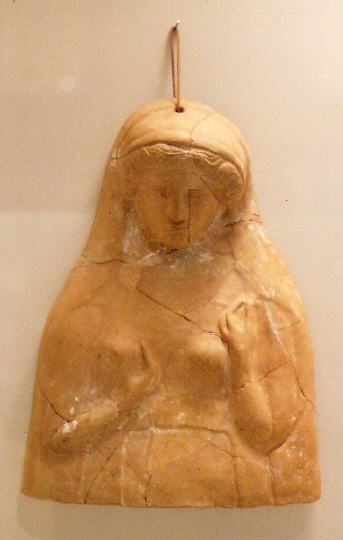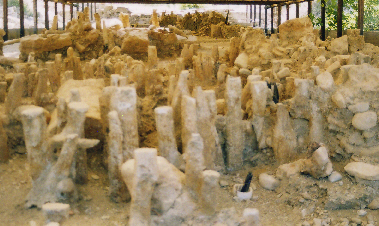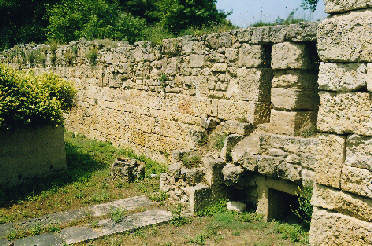The site at Amphípolis is spread over a very wide area and contains remains of the fifth century BC city, several Early Christian Basilicas and a Hellenistic house.
There is also a fine museum.

| Journey through Ancient Greece | |
| Amphípolis The site at Amphípolis is spread over a very wide area and contains remains of the fifth century BC city, several Early Christian Basilicas and a Hellenistic house. There is also a fine museum. |
 |
| History The ancient city, originally known as Ennea Odoi (Nine Roads), was first established by Thracians in a bend of the river Strymon at the foot of Mount Pangaion. Xerxes passed through on his way towards Thermopylae in 481 BC and, according to Herodotos, buried alive nine boys and nine girls. It was a wealthy city because of the gold and silver found on Mount Pangaion and the surrounding forests which provided wood for ship building. Because of this it was colonised by the Athenians, under Hagnon, in 437 BC. According to the historian Thukidides Hagnon called the city Amphípolis'because it was surrounded on two sides by the river Strymon, and he built it in such a way that it was a conspicuous sight both from the sea and from the side facing the mainland where he built a long wall across the loop of the river.' (bk 4 ch 8). In 424 only thirteen years after the Athenians founded the city the Spartans under the general Brasidas marched on Thrace. Thukidides, then the commander in chief of the Athenian fleet, was at the time on Thasos and when he heard that the Spartans had captured the city of Myrkinos near Amphípolis he set sail with seven triremes. Before he arrived the Spartans took Amphípolis and Thukidides was only able to save the port of Eion. He was blamed for the loss of Amphípolis, which the Athenians had considered a particularly valuable asset and sent into exile for twenty years. (It was during this period of exile that he wrote his history of the Peloponnesian Wars.) The Athenians led by Kleon tried to recapture Amphípolis in 422 BC but the inhabitants decided to hedge their bets with the Spartans and fought off the invaders killing 600 Athenians including Kleon. The Spartans lost only six men one of whom was Brasidas who was buried in front of the agora. The people of Amphípolis held annual games here in his honour and gave him the official title of founder of their colony. (Thukidides Bk5 ch1) Amphípolis continued to thwart attempts by Athens to take her back and also fought off attempts by Macedonian kings until it was finally captured by Philip II in 357. It was from here that Alexander set off for Asia, his fleet and army gathering on the Strymon to prepare for the campaign, and here that his wife Roxanne and son Alexander IV were exiled after his death. Because of its proximity to the Via Egnatia, Amphípolis retained its strategic importance through the Roman and Early Christian periods. Following the Battle of Pydna in 168 BC Amphípolis became the capital of one of four Roman republics. Saint Paul visited the city on his way from Philippi to Thessaloníke in AD 50. |
| The Museum In this excellent museum there are many fine exhibits from all the periods of the site from Late Neolithic through to Byzantine, with comprehensive information in English. In the foyer is a 4th century silver ossuary on top of which is the gold olive wreath which was found inside. Downstairs there are finds from a Macedonian tomb including more gold wreaths, necklaces, and domestic items including a bed,a comb and a shoe. There are also a number of lovely clay busts of female deities from the 4th century, some natural terracotta and some painted white. |
 |
| The Site We will have to be accompanied by a curator on our visit so what we see will depend to a large extent on them - and also on the weather. Last year when we were there it was raining so much we had to abandon our visit because of the mud, rather appropriately as the site has had problems with flooding since ancient times! The remains of an ancient wooden bridge over the Strymon are fascinating, and as far as I know unique. It is difficult to make out the arrangement of the posts but the archaeologist describes them as 'set in groups of three or four to strengthen the substructure of the bridge, and form twelve roughly parallel rows with a total width of 4-6 metres which must have been the width of the Classical Bridge. The end of the stakes were sharpened to a point, which in some cases was inserted into a pointed iron head.' A number of iron heads have been found as well as iron tools. Pottery found at the site suggests the bridge was built in the 5th century BC. |
 |
| Close to the bridge is the north wall part of the 7.5
kilometres of wall which surrounded the city (the
wall around the acropolis was a further 2 kilometres
long). Excavation dates the wall to 424 to 422 BC fitting
in with Thukidides description of the battle between
Brasidas and Kleon in which he refers to 'the first
gate in the long wall, which was then in existence.' (bk5 ch1). This section
of wall is well preserved and much of it stands over 7
metres high. The wall had a series of drainage conduits to carry off the flood water from the river, remains of which we can see. There are also remains of a number of square and round towers. There are two gates in this section of wall, one from the Classical period and one from the Hellenistic period. The wall ends at the point where the bank of the hill rises so steeply that a wall was unnecessary. In front of the wall are the remains of a Thesmophorian, a small unroofed building divided into two unequal sections. In the centre of the larger part you can see the neck of a large pithos which was set in the ground to form a well; around it were found a number of figurines of women or female deities. Fifty vases were found stacked in the corner of the room. Many of the vases and figurines are in the museum. A short drive away on the acropolis are the remains of five churches dating from the 5th & 6th centuries. Four of these are in basilica style and one has a hexagonal interior. We can see the fine mosaic floors of three of the Basilicas. A few Corinthian capitals are all that remain of the colonnades of Basilica 'A'. Another short drive brings you to the remains of a Hellenistic House, with some remarkably well preserved painted walls. |

|